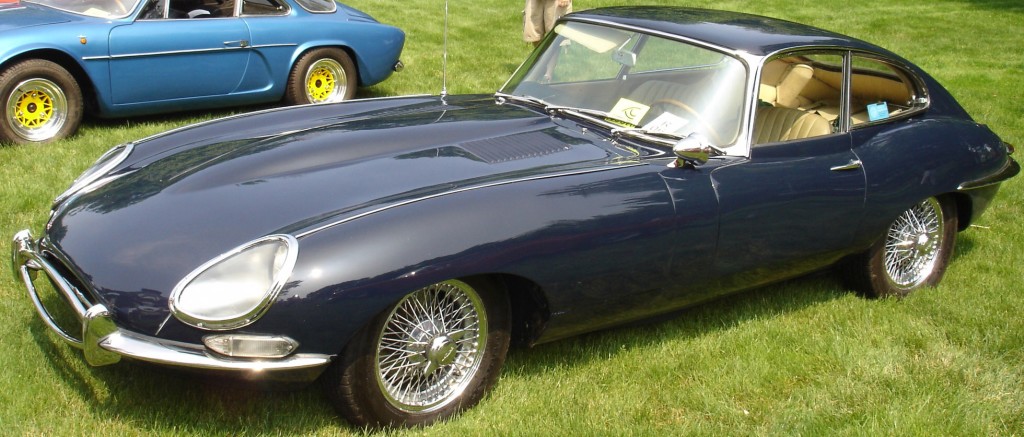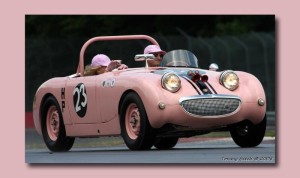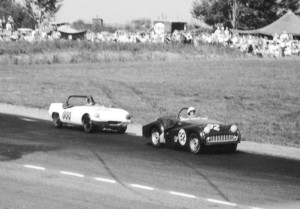The Internet is amazing. Sometimes you think your childhood past is actually an invented thing. I was trying to explain to my wife — recent convert to Formula 1 racing — about the Vineland Speedway in south Jersey. Tried to frame what it was like to drive in the entrance, which had a, to me, spectacular marquee featuring a dead Kaiser Frazier atop a simple sign. Then, lo and behold, I found the photo above. Exactly as I remembered it.
I’d been teasing her about F1 drivers past, quizzing her about which ones were still alive and which had perished in the world’s most dangerous sport. I mean, if you’re going to plight a troth of this sort, you should know the bodies on which it is built. Because there are a lot of bodies.
The memory of one of the dead drivers propelled me back to the Vineland Speedway, where I experienced many wondrous things as a child in the early 1960s. Events aplenty. Sights, certainly. But also the keenest triggers memory has — smells. Two stand out. In the bleacher seats at the Speedway, the comforting, enfolding aroma of cherry pipe tobacco, which neither of the pipe smokers in my family could stomach. But to my ten year old nose it was beatific.
But cherry tobacco can’t hold a candle to the other smell, which in my mind is still the single best smell I have ever smelled, including you know what. It was that good, that arousing, that magnificent. It’s called Castrol R. A racing motor oil made of castor beans.
On the Sundays when there was sports car racing at Vineland Speedway, the air was pregnant with Castrol R heated to a racing temperature. I won’t describe it because no one can. Just think of it as heroin for the nose. Why it’s the sensory trigger it is. A friend of mine and I bought a Norton motorcycle together and put the miraculous lubricant into its crankcase just so we could have the olfactory experience again. It’s not good mechanical practice. If you’re not using the motor more or less continuously, it turns into a whitish gel that gums up the works. But we were young and couldn’t resist.
Where was I? Just past the entrance, off a nondescript and cluttered highway called Route 47, was the parking lot. Orange gravel, no painted lines, just cars of people there for the races. But such cars. License plates from all over the eastern seaboard. How could they even know to come here, to a backwoods track in Vineland, NJ? But here they were. Austin Healeys, MGAs, Morgans, Lotus 7s, even Bentleys and Rolls Royces. And this, which was for me an imprinting experience, the first time I laid eyes on the brand new, heretofore only rumored, masterpiece called the XKE.

Exactly the same as the car I fell fatally in love with. Except there was no grass. Just orange gravel.
You thought I was going to talk racing? I will. The track was narrow and short, although there was a stretch out of sight of the stands. Suspense. Who would be in the lead when they emerged from the hidden part. When I was young I didn’t know the track was short. In my teenage years, though, my friend of the Castrol R fixation and I found the shut down circuit (now part of a community college campus) and ran it in his XKE. Unbelievably narrow, unbelievably tight, with an unbelievably nasty chicane. About there, we hit a dirt bike rider who had the same idea we did. He was unhurt. We shook hands and went our separate ways.
The only real straightaway was immediately in front of the stands. That’s where I saw the first SCCA showdown between a 289 Cobra and a Corvette. Both cars were way too much for such a tinsel track. The Corvette actually had better handling (who’d a thunk it?) and led on the first lap into the straightaway. Then the Cobra thing happened. The driver pressed the accelerator and devoured the Corvette within the first two hundred yards. Never looked back. Never had to.
I saw other things on the Speedway track. Before there was Danica there was Janet Guthrie. Before there was Janet Guthrie, there was Donna Mae Mims.
We saw her at the Vineland Speedway. And, yes, back in those dark and oppressive male chauvinist days, we cheered for her like the dickens. Not ironically at all. We wanted her to win. Which she did. The first female SCCA champion in history. The past is not always what you’ve been taught it is.

Imagine. Us flyover hicks from the Jersey backwoods rooting our hearts out for a woman in the most dangerous, most manliest life and death sport. Can’t do it? Sorry for you.
Saw other things you wouldn’t expect in the backwoods either. There was the driver in an Elva Courier with the number ‘000.’ He was simply beyond compare.
The races were typically 25 laps. Triple-Zero typically lapped every other car in the race, meaning he began in the lead and then overtook every car behind him before the race was over. The driver was named Mark Donohue. How this post got started. I asked my wife how many drivers I had seen in person died on the track eventually. He’s the one.
Funny. In those long lost years I also had the good fortune to travel the course of the Monte Carlo Grand Prix, because my dad was almost as crazy about racing as I was, but that’s a faint and, well, unconvincing memory to me now, because there was no cherry pipe tobacco, no Castrol R, and no local sense of identity about it. It was just a stunt we pulled. The Vineland Speedway was life being lived the way I’ve always wanted to live it.
N.B. Explaining the asterisk above. SCCA stands for Sports Car Club of America. One of the future champions who raced at Vineland was this guy.

Can’t think of his name offhand, but he was nearly as good, or at least in the approximate ballpark, with Steve McQueen.
P.S. Another question my wife flunked. Who’s the driver who invented the tradition of spraying everybody with Champagne after a big win?
Like all people who value education, she’s glad to learn about Dan. And she thinks he was better looking than both Steve McQueen and Paul Newman. He coulda shoulda been a movie star.





